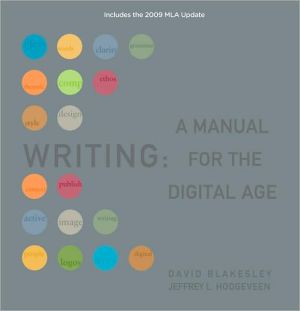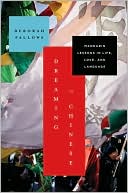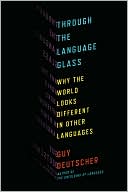Writing: A Manual for Digital Age, Comprehensive, 2009 MLA Update Edition
One of the best ways to excel in your writing course is by using WRITING: A MANUAL FOR THE DIGITAL AGE. Whatever your writing assignment-personal essay, persuasive essay, critical review, photographic essay, technology autobiography, blog, website, or more than twenty other different kinds of writing projects-WRITING: A MANUAL FOR THE DIGITAL AGE gives you the answers and help you need to succeed. And best of all, this information is right at your fingertips thanks to the handbook's...
Search in google:
One of the best ways to excel in your writing course is by using WRITING: A MANUAL FOR THE DIGITAL AGE. Whatever your writing assignment-personal essay, persuasive essay, critical review, photographic essay, technology autobiography, blog, website, or more than twenty other different kinds of writing projects-WRITING: A MANUAL FOR THE DIGITAL AGE gives you the answers and help you need to succeed. And best of all, this information is right at your fingertips thanks to the handbook's easy-to-access format, which you'll find as visually interesting and easy to navigate as your favorite website! Whether you need grammar help, or information on drafting and shaping content, developing paragraphs, researching online, citing sources, using visuals, writing on the Web, and so much more, this is the handbook that will get you there! This edition has been updated to reflect guidelines from the 2009 MLA Handbook for Writers of Research Papers, Seventh Edition.
Part I: MANAGING YOUR WRITING. 1. Writing and Rhetoric in Context. 2. Planning Your Writing Projects. 3. Invention and Inquiry. 4. Drafting and Shaping Content. 5. Developing Paragraphs. 6. Revising, Editing, and Proofreading. Part II: READING AND WRITING CRITICALLY. 7. Understanding Academic Genres. 8. Reading Critically. 9. Reading Literature Critically. 10. Reading Images Critically. 11. Writing Arguments. 12. Writing for Business and the Workplace. 13. Writing on the Spot: Essay Examinations. Part III: CONDUCTING RESEARCH. 14. Conceptualizing the Research Project. 15. Online Research. 16. Library and Field Research. 17. Using Information Effectively. 18. Research and Plagiarism in the Digital Age. Part IV: CITING SOURCES. 19. Citing Sources in MLA Style. 20. Citing Sources in APA Style. 21. Citing Sources in CMS Style. 22. Citing Sources in CSE Style. 23. Using CGOS Citations for Online Sources. Part V: DESIGNING AND PRESENTING INFORMATION. 24. Using Visuals to Inform and Persuade. 25. Desktop Publishing and Graphic Design for Writers. 26. Designing Interactive Oral Presentations. Part VI: WRITING IN DIGITAL SPACES. 27. Reading and Writing Email Purposefully. 28. Networking with Others on the Web. 29. Writing and Rhetoric on the Web. 30. Designing Simple Web Pages. 31. Designing Complex Websites. 32. Multimedia Composing. Part VII: MAKING CHOICES ABOUT STYLE. 33. Sentences in Context. 34. Parallelism. 35. Coordination and Subordination. 36. Concise Sentences. 37. Variety and Emphasis. 38. Effective Word Use. 39. Language and Diverse Audiences. Part VIII: UNDERSTANDING AND REVISING SENTENCES. 40. Parts of Speech and Sentence Structure. 41.Fragments. 42. Run-Ons and Comma Splices. 43. Pronouns. 44. Verbs. 45. Subject-Verb Agreement. 46. Adjectives, Adverbs, and Modifying Phrases. Part IX: PUNCTUATING WITH PURPOSE. 47. End Punctuation: Defining Sentence Types and Boundaries. 48. Commas: Defining Boundaries within Sentences. 49. Semicolons: Expressing Equal Relationships among Closely Related Ideas. 50. Colons: Introducing Explanations and Quotations. 51. Apostrophes: Showing Possession and Forming Contractions. 52. Quotation Marks: Attributing Words to People and Conveying Tone. 53. Other Punctuation Marks. Part X: UNDERSTANDING MECHANICS. 54. Abbreviations. 55. Numbers. 56. Italics. 57. Capitalization. 58. Spelling and Hyphens. Part XI: GRAMMAR FOR MULTILINGUAL WRITERS. 59. ESL Writing for Academic Purposes. 60. Nouns and Articles. 61. Verbs and Verbals. 62. English Sentence Structure. Part XII: GLOSSARIES. Glossary of Technology and Web Terms. Glossary of Grammatical Terms. Glossary of Usage.








